现在分词和过去分词做表语和定语
- 格式:ppt
- 大小:1.43 MB
- 文档页数:16
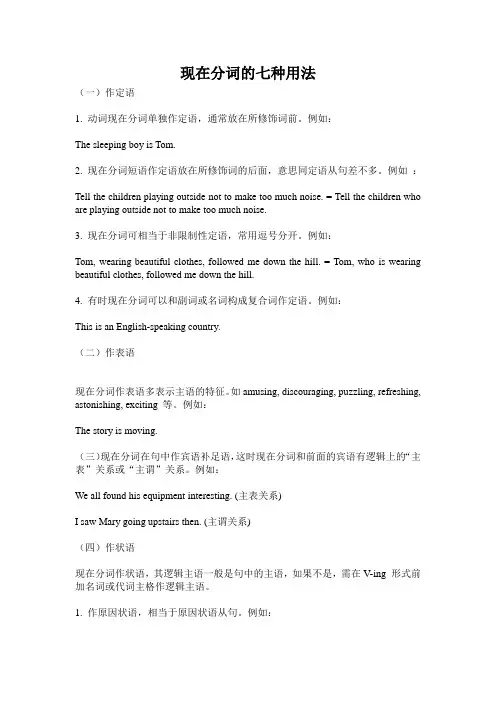
现在分词的七种用法(一)作定语1. 动词现在分词单独作定语,通常放在所修饰词前。
例如:The sleeping boy is Tom.2. 现在分词短语作定语放在所修饰词的后面,意思同定语从句差不多。
例如:Tell the children playing outside not to make too much noise. = Tell the children who are playing outside not to make too much noise.3. 现在分词可相当于非限制性定语,常用逗号分开。
例如:Tom, wearing beautiful clothes, followed me down the hill. = Tom, who is wearing beautiful clothes, followed me down the hill.4. 有时现在分词可以和副词或名词构成复合词作定语。
例如:This is an English-speaking country.(二)作表语现在分词作表语多表示主语的特征。
如amusing, discouraging, puzzling, refreshing, astonishing, exciting 等。
例如:The story is moving.(三)现在分词在句中作宾语补足语,这时现在分词和前面的宾语有逻辑上的“主表”关系或“主谓”关系。
例如:We all found his equipment interesting. (主表关系)I saw Mary going upstairs then. (主谓关系)(四)作状语现在分词作状语,其逻辑主语一般是句中的主语,如果不是,需在V-ing 形式前加名词或代词主格作逻辑主语。
1. 作原因状语,相当于原因状语从句。
例如:Being ill, Mary didn't come to school yesterday.2. 作时间状语,相当于时间状语从句。
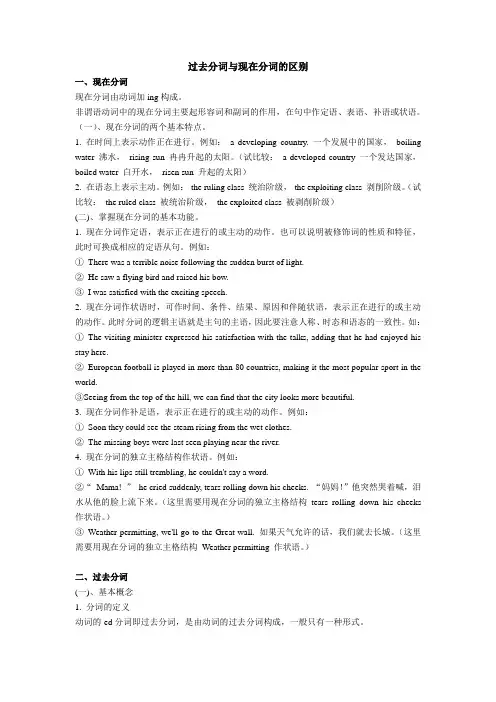
过去分词与现在分词的区别一、现在分词现在分词由动词加ing构成。
非谓语动词中的现在分词主要起形容词和副词的作用,在句中作定语、表语、补语或状语。
(一)、现在分词的两个基本特点。
1. 在时间上表示动作正在进行。
例如:a developing country. 一个发展中的国家,boiling water 沸水,rising sun 冉冉升起的太阳。
(试比较:a developed country 一个发达国家,boiled water 白开水,risen sun 升起的太阳)2. 在语态上表示主动。
例如:the ruling class 统治阶级,the exploiting class 剥削阶级。
(试比较:the ruled class 被统治阶级,the exploited class 被剥削阶级)(二)、掌握现在分词的基本功能。
1. 现在分词作定语,表示正在进行的或主动的动作。
也可以说明被修饰词的性质和特征,此时可换成相应的定语从句。
例如:①There was a terrible noise following the sudden burst of light.②He saw a flying bird and raised his bow.③I was satisfied with the exciting speech.2. 现在分词作状语时,可作时间、条件、结果、原因和伴随状语,表示正在进行的或主动的动作。
此时分词的逻辑主语就是主句的主语,因此要注意人称、时态和语态的一致性。
如:①The visiting minister expressed his satisfaction with the talks, adding that he had enjoyed his stay here.②European football is played in more than 80 countries, making it the most popular sport in the world.③Seeing from the top of the hill, we can find that the city looks more beautiful.3. 现在分词作补足语,表示正在进行的或主动的动作。
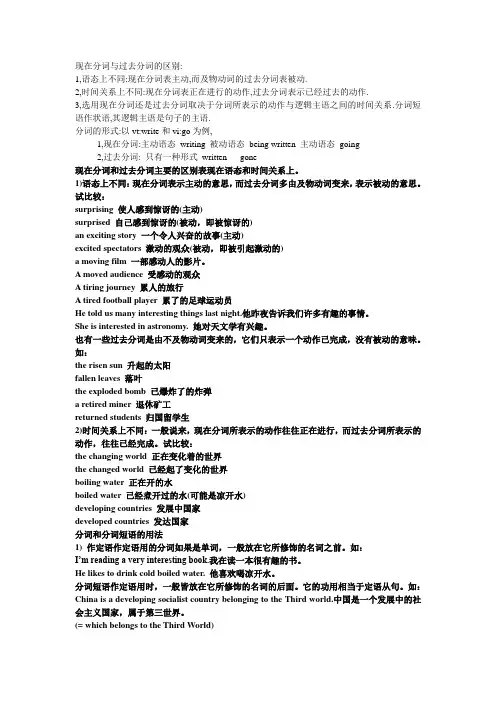
现在分词与过去分词的区别:1,语态上不同:现在分词表主动,而及物动词的过去分词表被动.2,时间关系上不同:现在分词表正在进行的动作,过去分词表示已经过去的动作.3,选用现在分词还是过去分词取决于分词所表示的动作与逻辑主语之间的时间关系.分词短语作状语,其逻辑主语是句子的主语.分词的形式:以vt:write和vi:go为例,1,现在分词:主动语态writing 被动语态being written 主动语态going2,过去分词: 只有一种形式 written gone现在分词和过去分词主要的区别表现在语态和时间关系上。
1)语态上不同:现在分词表示主动的意思,而过去分词多由及物动词变来,表示被动的意思。
试比较:surprising 使人感到惊讶的(主动)surprised 自己感到惊讶的(被动,即被惊讶的)an exciting story 一个令人兴奋的故事(主动)excited spectators 激动的观众(被动,即被引起激动的)a moving film 一部感动人的影片。
A moved audience 受感动的观众A tiring journey 累人的旅行A tired football player 累了的足球运动员He told us many interesting things last night.他昨夜告诉我们许多有趣的事情。
She is interested in astronomy. 她对天文学有兴趣。
也有一些过去分词是由不及物动词变来的,它们只表示一个动作已完成,没有被动的意味。
如:the risen sun 升起的太阳fallen leaves 落叶the exploded bomb 已爆炸了的炸弹a retired miner 退休矿工returned students 归国留学生2)时间关系上不同:一般说来,现在分词所表示的动作往往正在进行,而过去分词所表示的动作,往往已经完成。
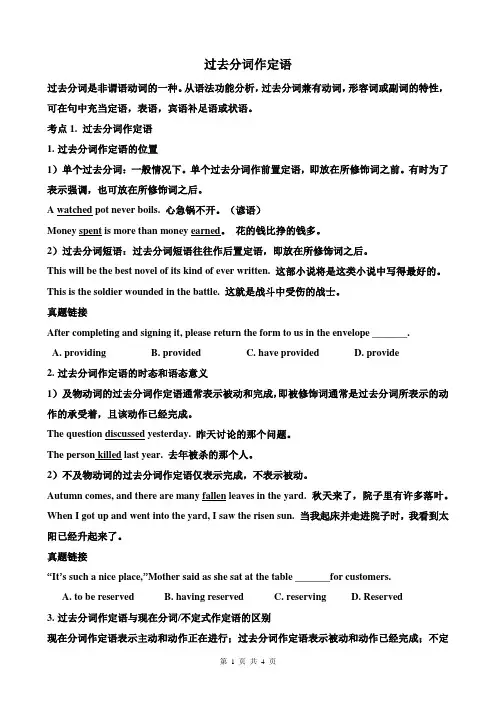
过去分词作定语过去分词是非谓语动词的一种。
从语法功能分析,过去分词兼有动词,形容词或副词的特性,可在句中充当定语,表语,宾语补足语或状语。
考点1. 过去分词作定语1.过去分词作定语的位置1)单个过去分词:一般情况下。
单个过去分词作前置定语,即放在所修饰词之前。
有时为了表示强调,也可放在所修饰词之后。
A watched pot never boils. 心急锅不开。
(谚语)Money spent is more than money earned。
花的钱比挣的钱多。
2)过去分词短语:过去分词短语往往作后置定语,即放在所修饰词之后。
This will be the best novel of its kind of ever written. 这部小说将是这类小说中写得最好的。
This is the soldier wounded in the battle. 这就是战斗中受伤的战士。
真题链接After completing and signing it, please return the form to us in the envelope _______.A. providingB. providedC. have providedD. provide2.过去分词作定语的时态和语态意义1)及物动词的过去分词作定语通常表示被动和完成,即被修饰词通常是过去分词所表示的动作的承受着,且该动作已经完成。
The question discussed yesterday. 昨天讨论的那个问题。
The person killed last year. 去年被杀的那个人。
2)不及物动词的过去分词作定语仅表示完成,不表示被动。
Autumn comes, and there are many fallen leaves in the yard. 秋天来了,院子里有许多落叶。
When I got up and went into the yard, I saw the risen sun. 当我起床并走进院子时,我看到太阳已经升起来了。
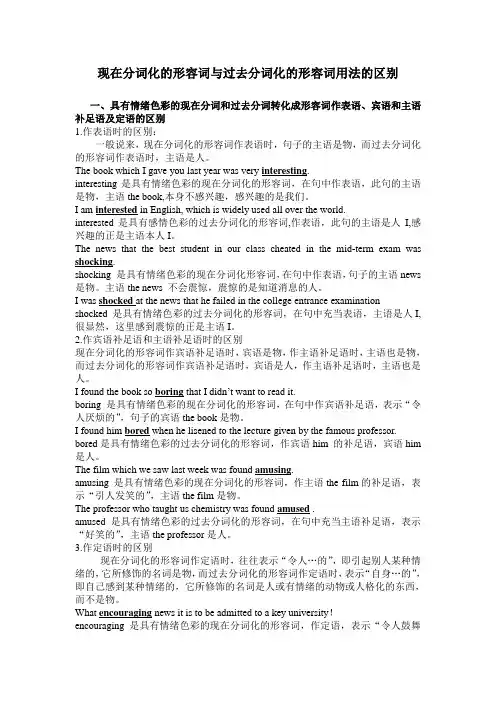
现在分词化的形容词与过去分词化的形容词用法的区别一、具有情绪色彩的现在分词和过去分词转化成形容词作表语、宾语和主语补足语及定语的区别1.作表语时的区别:一般说来,现在分词化的形容词作表语时,句子的主语是物,而过去分词化的形容词作表语时,主语是人。
The book which I gave you last year was very interesting.interesting是具有情绪色彩的现在分词化的形容词,在句中作表语,此句的主语是物,主语the book,本身不感兴趣,感兴趣的是我们。
I am interested in English, which is widely used all over the world.interested是具有感情色彩的过去分词化的形容词,作表语,此句的主语是人I,感兴趣的正是主语本人I。
The news that the best student in our class cheated in the mid-term exam was shocking.shocking 是具有情绪色彩的现在分词化形容词,在句中作表语,句子的主语news 是物。
主语the news 不会震惊,震惊的是知道消息的人。
I was shocked at the news that he failed in the college entrance examination shocked 是具有情绪色彩的过去分词化的形容词,在句中充当表语,主语是人I,很显然,这里感到震惊的正是主语I。
2.作宾语补足语和主语补足语时的区别现在分词化的形容词作宾语补足语时,宾语是物,作主语补足语时,主语也是物,而过去分词化的形容词作宾语补足语时,宾语是人,作主语补足语时,主语也是人。
I found the book so boring that I didn’t want to read it.boring 是具有情绪色彩的现在分词化的形容词,在句中作宾语补足语,表示“令人厌烦的”,句子的宾语the book是物。
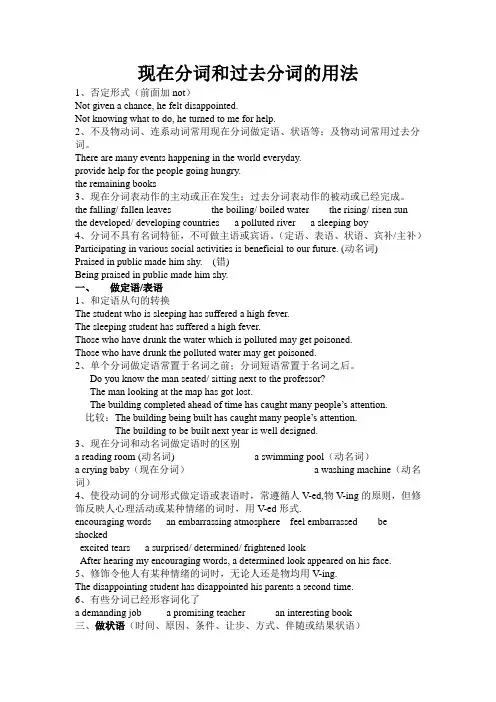
现在分词和过去分词的用法1、否定形式(前面加not)Not given a chance, he felt disappointed.Not knowing what to do, he turned to me for help.2、不及物动词、连系动词常用现在分词做定语、状语等;及物动词常用过去分词。
There are many events happening in the world everyday.provide help for the people going hungry.the remaining books3、现在分词表动作的主动或正在发生;过去分词表动作的被动或已经完成。
the falling/ fallen leaves the boiling/ boiled water the rising/ risen sun the developed/ developing countries a polluted river a sleeping boy4、分词不具有名词特征,不可做主语或宾语。
(定语、表语、状语、宾补/主补)Participating in various social activities is beneficial to our future. (动名词)Praised in public made him shy. (错)Being praised in public made him shy.一、做定语/表语1、和定语从句的转换The student who is sleeping has suffered a high fever.The sleeping student has suffered a high fever.Those who have drunk the water which is polluted may get poisoned.Those who have drunk the polluted water may get poisoned.2、单个分词做定语常置于名词之前;分词短语常置于名词之后。
![分词ing型和ed型在英语中的用法及含义[整理版]](https://uimg.taocdn.com/fd59762d86c24028915f804d2b160b4e767f81a5.webp)
分词ing型和ed型在英语中的用法及含义现在分词ing型具有动词的特征以及形容词或副词的功能,可以作表语、定语、状语或在复合结构中作宾补。
现在分词ing型具有主动意义。
而过去分词ed型说明主语情感心理上的感受,往往具有被动的意义。
1、现在分词ing型作表语:表示情感心理的及物动词的现在分词具有主动意义,表示主语的特征,能引起听话人情感心理上的反应。
例如:a. The situation is encouraging. 形势很使人鼓舞。
She is greatly encouraged. 她深受鼓舞。
b. The food smells inviting. 这个才真诱人。
I don’t feel invited to enter such an ugly building. 我没有欲望进这么难看的建筑。
最常这样用的分词有:amazing / amazed,astonishing / astonished,surprising / surprised,encouraging / encouraged,confusing / confused,disappointing / disappointed,exc iting / excited,interesting / interested,puzzling / puzzled,shocking / shocked,worrying / worried,tiring / tired,satisfying / satisfied2、现在分词ing型作定语1)上述表示情感心理的及物动词的现在分词可以作前置定语,仍然表示它所修饰的名词的特征,能引起听话人情感心理上的反应。
它们与对应的过去分词作定语的区别同上。
He told us the disappointing news. 他告诉我们那令人失望的消息。
The amusing story set the amused audience laughed all the time. 令人捧腹的故事令感到好笑的观众大笑不止。
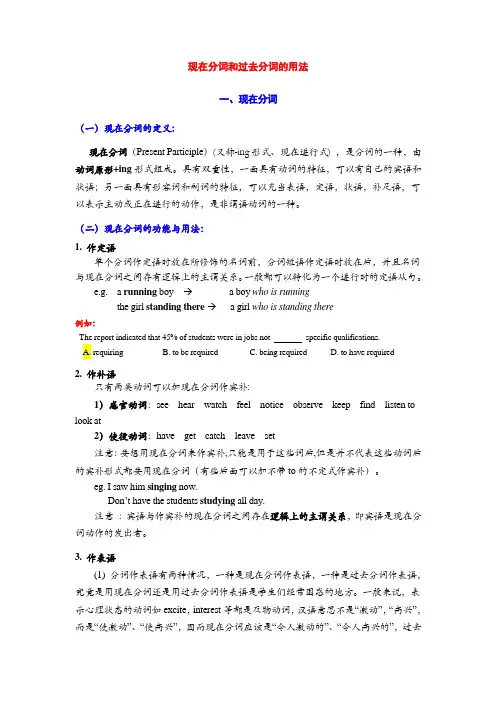
现在分词和过去分词的用法一、现在分词(一)现在分词的定义:现在分词(Present Participle)(又称-ing形式、现在进行式) ,是分词的一种,由动词原形+ing形式组成。
具有双重性,一面具有动词的特征,可以有自己的宾语和状语;另一面具有形容词和副词的特征,可以充当表语,定语,状语,补足语,可以表示主动或正在进行的动作,是非谓语动词的一种。
(二)现在分词的功能与用法:1. 作定语单个分词作定语时放在所修饰的名词前,分词短语作定语时放在后,并且名词与现在分词之间存有逻辑上的主谓关系。
一般都可以转化为一个进行时的定语从句。
e.g. a running boy→ a boy who is runningthe girl standing there → a girl who is standing there例如:The report indicated that 45% of students were in jobs not specific qualifications.A. requiringB. to be requiredC. being requiredD. to have required2. 作补语只有两类动词可以加现在分词作宾补:1)感官动词:see hear watch feel notice observe keep find listen tolook at2)使役动词:have get catch leave set注意:要想用现在分词来作宾补,只能是用于这些词后,但是并不代表这些动词后的宾补形式都要用现在分词(有些后面可以加不带to的不定式作宾补)。
eg. I saw him singing now.Don’t have the students studying all day.注意:宾语与作宾补的现在分词之间存在逻辑上的主谓关系,即宾语是现在分词动作的发出者。
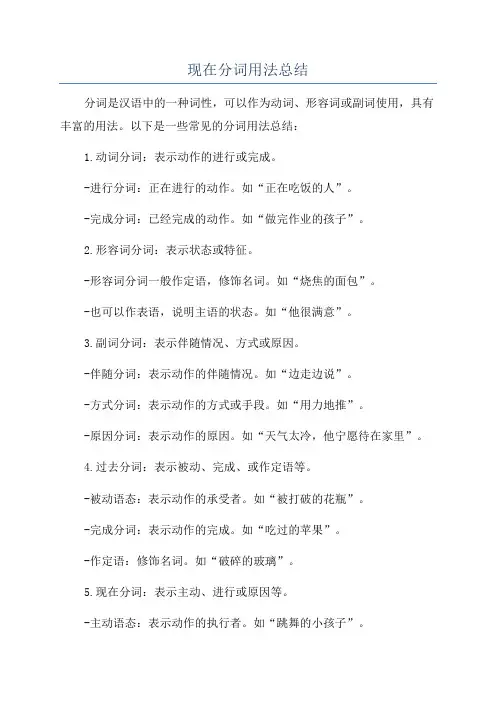
现在分词用法总结
分词是汉语中的一种词性,可以作为动词、形容词或副词使用,具有丰富的用法。
以下是一些常见的分词用法总结:
1.动词分词:表示动作的进行或完成。
-进行分词:正在进行的动作。
如“正在吃饭的人”。
-完成分词:已经完成的动作。
如“做完作业的孩子”。
2.形容词分词:表示状态或特征。
-形容词分词一般作定语,修饰名词。
如“烧焦的面包”。
-也可以作表语,说明主语的状态。
如“他很满意”。
3.副词分词:表示伴随情况、方式或原因。
-伴随分词:表示动作的伴随情况。
如“边走边说”。
-方式分词:表示动作的方式或手段。
如“用力地推”。
-原因分词:表示动作的原因。
如“天气太冷,他宁愿待在家里”。
4.过去分词:表示被动、完成、或作定语等。
-被动语态:表示动作的承受者。
如“被打破的花瓶”。
-完成分词:表示动作的完成。
如“吃过的苹果”。
-作定语:修饰名词。
如“破碎的玻璃”。
5.现在分词:表示主动、进行或原因等。
-主动语态:表示动作的执行者。
如“跳舞的小孩子”。
-进行分词:表示正在进行的动作。
如“唱歌的人”。
-原因分词:表示动作的原因。
如“为了庆祝生日的活动”。
这些只是分词的一些常见用法,实际上分词的用法非常灵活多样,需要根据句子的具体语境来确定。
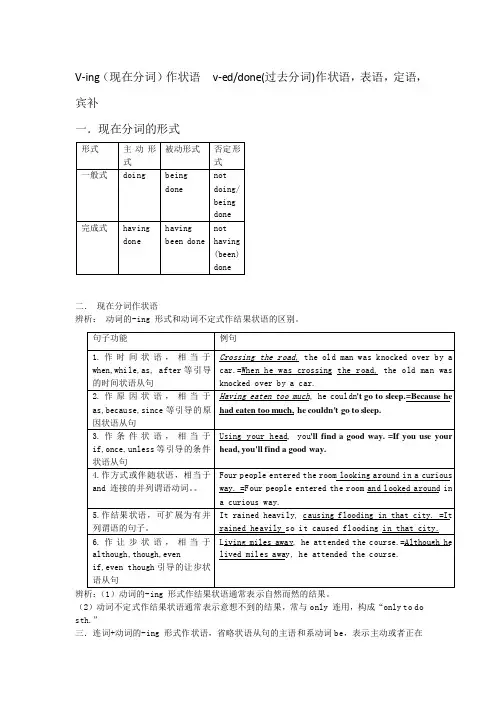
V-ing (现在分词)作状语v-ed/done(过去分词)作状语,表语,定语,宾补一.现在分词的形式形式主动形式被动形式否定形式一般式doing beingdone not doing/beingdone完成式havingdone having been done not having(been)done二.现在分词作状语辨析:动词的-ing 形式和动词不定式作结果状语的区别。
辨析:(1)动词的-ing 形式作结果状语通常表示自然而然的结果。
(2)动词不定式作结果状语通常表示意想不到的结果,常与only 连用,构成“only to do sth.”三.连词+动词的-ing 形式作状语,省略状语从句的主语和系动词be ,表示主动或者正在句子功能例句1.作时间状语,相当于when,while,as,after 等引导的时间状语从句Crossing the road,the old man was knocked over by a car.=When he was crossing the road,the old man was knocked over by a car.2.作原因状语,相当于as,because,since 等引导的原因状语从句Having eaten too much ,he couldn 't go to sleep.=Because he had eaten too much,he couldn't go to sleep.3.作条件状语,相当于if,once,unless 等引导的条件状语从句Using your head,you 'll find a good way.=If you use your head,you'll find a good way.4.作方式或伴随状语,相当于and 连接的并列谓语动词。
Four people entered the room looking around in a curious way.=Four people entered the room and looked around in a curious way.5.作结果状语,可扩展为有并列谓语的句子。
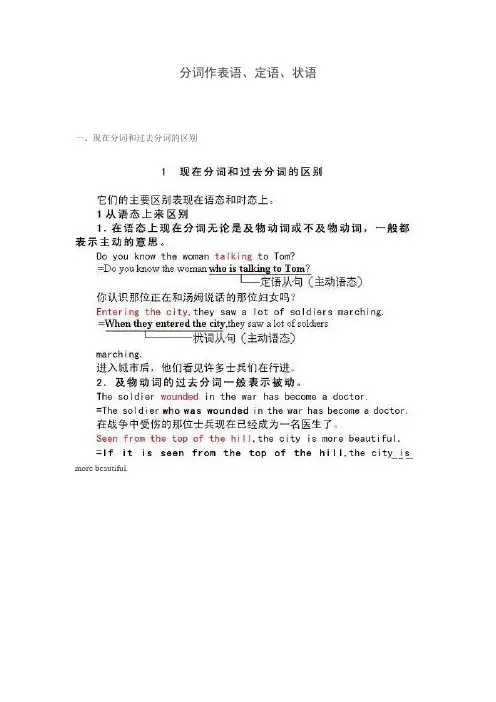
分词作表语、定语、状语一、现在分词和过去分词的区别more beautiful.二、分词的用法1分词作表语1)跟在系动词之后分词作表语,一般跟在be, get, become, look, sound, feel, keep,remain, grow, seem, appear 等系动词后面。
现在分词作表语:一般表主动或主语的性质和特征。
含有“令人⋯⋯”的意思。
主语多数情况下是物。
过去分词作表语:一般表被动或主语所处的状态。
含有“感到⋯⋯”的意思。
主语多数情况下是人。
而作表语用的分词,许多是由能够表示人们某种感情或情绪的动词变化而来的。
常见的原以下:现在分词:moving, interesting, encouraging, exciting,inspiring, boring,surprising, puzzling, amusing, astonishing,missing, promissing过去分词:interested, moved, discouraged, amused, astonished, frighten, excited, inspired, pleased, satisfied, tired, worried, completed, delighted, hurt, married, crowded。
The news sounds encouraging.这个消息听起来令人鼓舞。
How did the audience receive the new play?观众对这个新剧反映如何?They got very excited.他们非常激动。
How did Bob do in the exams this time?这次鲍伯考得怎么样?Well, his father seems pleased with his results.不错,他父亲似乎对于他的成绩感到高兴。
四种⾮谓语动词都可做表语和定语,如何轻松区分它们的⽤法?⾮谓语动词⽤法表表语和从上图我们可以看出四种⾮谓语动词:不定式、动名词、现在分词和过去分词都可⽤做表语和定语,要区别它们的⽤法看上去很⿇烦,但要只我们掌握了它们的基本规律,还是可以轻松区定语,分得。
下⾯我们⼀起来分析⼀下它们的⽤法规律:⼀、表语:⾮谓语动词做表语不定式:表⽰动作, 说明主语的内容 “是什么?” ⼀次性,某次,将来动名词: 表⽰动作, 说明主语的内容 “是什么?” ⼀般,普遍,经常现在分词: 表⽰状态, 说明主语性质,特点或所处状态“怎么样?”与主语有主动关系过去分词: 表⽰状态, 说明主语性质,特点或所处状态“怎么样?”与主语有被动关系注: 不及物动词的过分词做表语,不表⽰与主语有被动关系。
只表⽰完成。
f.g: So all she could do was to go back home.*What she hated most was resting at home and doing nothing.* How joyful and relaxing it is to have a game of table-tennis after a day of study at school.*Galileo was not discouraged. /It's sold and gone.⼆、定语:(1)不定式(后置)a. 与修饰名词主动关系;⽤⼀般主动式(to do),表⽰将来f.g:So he made some candles to give light.b. 与修饰名词被动关系,表⽰将来①与本句中的“主语”是主动关系时,⽤⼀般主动式(to do)f.g:Have you anything to say for yourself?②与本句中的“主语”是不不主动关系时,⽤⼀般被动式:to be donef.g:I’m going to the post office. Have you anything to besent?③不定式为“不及物动词+介词”作定语时,“介词”不可漏掉。
分词的分类及用法总结一、什么是分词?分词是指将一个复杂的句子分解成一个主句和一个或多个从句,从而使句子的结构更加清晰明了。
分词在英语语法中属于非谓语动词的一种形式,主要用于修饰主句的主语或宾语,以及表示原因、条件、时间等各种关系。
二、分词的基本形式分词主要有两种形式,即现在分词和过去分词。
现在分词以-ing结尾,过去分词根据动词的不规则变化进行构词。
三、分词的用法1. 现在分词用作形容词现在分词可用于描述人、事物或现象的性质和状态。
例:The running water sounded soothing.(奔流的水声听起来很舒服。
)2. 过去分词用作形容词过去分词可用于描述被动、完成或说明状态。
例:The broken vase lay on the floor.(打碎的花瓶摆在地板上。
)3. 现在分词用作主动性动词现在分词可作为主动性动词,表示正在进行的动作。
例:She is painting a picture.(她正在画一幅画。
)4. 现在分词用作被动性动词现在分词可作为被动性动词,表示被动的、正在进行的动作。
例:The car is being repaired.(汽车正在维修。
)5. 现在分词和过去分词用作状语现在分词和过去分词可用作状语,表示动作的原因、时间、条件或方式。
例:Feeling tired, she decided to take a break.(感到疲倦,她决定休息一下。
)Having finished his homework, he went out to play.(完成作业后,他出去玩了。
)6. 独立结构分词现在分词或过去分词放在句子开头或结尾,与主句之间没有直接的句法联系,构成独立结构。
例:Smiling, she greeted her friends.(微笑着,她向朋友们打招呼。
)四、分词的分类1. 现在分词和过去分词作后置定语这种分词修饰名词,放在名词后面,起到定语的作用。
重点语法:一、过去分词作表语:1、过去分词作表语并无完成或被动之意,而是表示主语状态或思想感情等。
例句:No wonder he is excited!He looked worried after reading the letter.When we heard of it, we were deeply moved.He seemed quite delighted at the idea.2、可以用作表语的常见的过去分词有:amused 愉快的 connected 连接的 broken 碎了的 closed 关闭的completed 完成的 astonished 吃惊的 covered 覆盖的 crowded 拥挤的delighted 高兴的 disappointed失望的 dressed 穿着的 drunk 喝醉的experienced 有经验的 gone 遗失的 lost 丢失的 worried 担忧的interested 有兴趣的 tired 劳累的 pleased 高兴的 satisfied 满意的surprised 吃惊的 married 已婚的 known 著名的例句:The children are really excited about going to the zoo.孩子们对去动物园都很兴奋。
(表示一种感受)His wound became infected with a new virus.他的伤口感染了一种新的病毒。
(表示一种状态)3、注意区分过去分词作表语和被动语态分词作表语表示主语的状态,被动语态则表示被动的动作。
例:My glasses are broken.My glasses are broken by my son.On the earth, 70% of the surface is covered with water.I was greatly surprised by the knock at the door.二、过去分词作定语:done作定语时,其语法功能相当于一个定语从句。
现在分词与过去分词的用法分词作为英语语法的一种形式,在句子中起到了重要的作用。
其中,现在分词和过去分词是两种常见的形式,在句子中可用于表示动作或状态的变化。
本文将详细介绍现在分词和过去分词的用法及示例。
一、现在分词的用法1. 现在分词作状语现在分词可用作状语,修饰主句中的动词或整个句子。
它可以表示伴随、原因、结果等关系。
例1:Walking in the park, she enjoyed the beautiful scenery.(伴随关系)例2:Being tired, he decided to take a break.(原因关系)例3:The car crashed into a tree, killing the driver instantly.(结果关系)2. 现在分词作定语现在分词可以形容名词,作为定语修饰名词。
例4:The crying baby woke up the whole neighborhood.(形容词)例5:The running water sounded soothing.(形容词)3. 现在分词与现在分词短语现在分词与现在分词短语可以作主语、宾语、表语、宾补等。
例6:Smiling is contagious.(主语)例7:I saw him playing basketball in the park.(宾语)例8:Her main duty is taking care of the patients.(表语)例9:They kept the fire burning all night.(宾补)二、过去分词的用法1. 过去分词作定语过去分词可以修饰名词,作为定语使用。
例10:The broken window has been fixed.(形容词)例11:I visited the abandoned house yesterday.(形容词)2. 过去分词与过去分词短语过去分词与过去分词短语可以用作被动语态、完成时态、副词等。